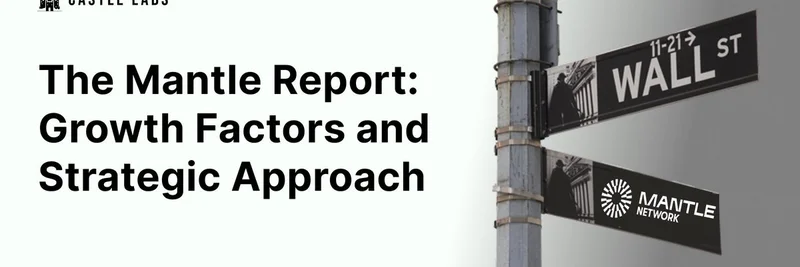Hey there, crypto enthusiasts! If you've been keeping an eye on the blockchain space, you might have caught wind of some exciting updates from Mantle Network. Recently, Castle Labs shared a tweet highlighting Mantle's strong performance in August, while pointing folks to their detailed report on the network's growth factors and strategic moves. Let's break it down in simple terms and see why this matters, especially if you're into meme tokens and the wild world of decentralized finance (DeFi).
Mantle's August Metrics: A Snapshot of Success
Mantle Network kicked off September with a bang, releasing their "by the numbers" update for August. The stats are impressive and show real momentum in user adoption and economic activity. Here's a quick rundown:
- Monthly Active Users: Surged by 48.6% to over 89.5K.
- Total Value Locked (TVL): Climbed 26.27% to $2.2 billion.
- Stablecoin Supply: Grew 14.20% to more than $643 million.
- Stablecoin Volume: Increased by 3.75% to $8.3 million.
These numbers aren't just fluff—they signal a thriving ecosystem that's attracting more participants. For meme token creators and traders, this means better liquidity and more opportunities to launch and trade fun, community-driven projects on a scalable Layer 2 network like Mantle, which keeps fees low and speeds high.
Diving into the Report: What Drives Mantle's Growth?
Castle Labs' report, titled "The Mantle Report: Growth Factors and Strategic Approach," digs deep into why Mantle is standing out in a crowded field of Layer 2 solutions. Mantle isn't just another Ethereum scaler; it's focusing on blending real-world finance (TradFi) with crypto, which could open doors for meme tokens to reach broader audiences.
Launched in July 2023 as an incubation from BitDAO (with ties to the exchange Bybit), Mantle quickly gained traction. One big hit was their liquid staking token, mETH, which locked up over $340 million in TVL within five months. Today, mETH ranks as the fourth-largest liquid staking token with more than $1.69 billion in TVL, holding a solid 1.35% market share. Liquid staking, by the way, lets you stake your ETH while still using it in DeFi—super handy for earning yields without locking away your assets.
To kickstart adoption, Mantle rolled out a $200 million strategic fund, drawing in major protocols and boosting its TVL to make it one of the top Layer 2s. On the tech side, they've gone modular: using EigenDA for data availability and building an EVM-compatible execution layer for better scalability and lower costs. Their Helios initiative even separates execution and consensus layers, allowing verification across multiple blockchains.
But what really sets Mantle apart is its massive treasury—over $3.1 billion, with 81% in native MNT tokens. This puts them in the top 10 for BTC and ETH holdings among crypto projects. Instead of splashing cash on short-term hype, they're using it for long-term incentives in key areas like DeFi and institutional tools. For meme token devs, this could mean grants or partnerships to build viral projects on Mantle.
Bridging DeFi and TradFi: A Game-Changer for Meme Ecosystems
The report highlights Mantle's pivot toward institutional finance and banking, aiming to bridge DeFi with traditional systems. Enter UR (in beta), a unified financial account that handles both fiat and onchain transactions. Think of it as a one-stop shop for tokenized equity, forex, DEX trading, banking, and even insurance. Features include a Swiss IBAN, Mastercard debit card, and access to global payment rails.
Mantle also acquired ReserveOne, a crypto index fund for big investors, further solidifying their institutional play. The native token, MNT, is central here—it's the gas token, gives voting rights, and powers products like UR. You'll find MNT in CeFi spots like Bybit's Launchpool and DeFi platforms for collateral, liquidity, and staking (think Pendle, Dolomite, Merchant Moe, WOOFI).
Key ecosystem pillars include:
- mETH: For liquid staking.
- UR: The bridge to mainstream finance.
- Mantle Index Four (MI4): Likely an index product.
- Function BTC (FBTC): Bringing Bitcoin into DeFi use cases.
For meme tokens, this setup means easier on-ramps for new users. Imagine launching a meme coin and having seamless fiat integration—more retail traders jumping in without the usual hurdles.
Looking Ahead: Mantle's Roadmap and Implications for Meme Tokens
The future looks bright, according to the report. Mantle is doubling down on institutional and banking products, tightening ties with Bybit (which boasts 70 million users). Expect MNT-denominated trading pairs, options, and VIP perks. They're also pushing to become the biggest zero-knowledge (ZK) chain by year's end, which enhances privacy and efficiency—perfect for meme token trades that need speed and low costs.
Other plans include onchain financial services, real-world assets (RWAs), and potential MNT supply reductions through burns. Clearer regulations could fuel institutional demand, bringing more capital into the ecosystem.
If you're building or investing in meme tokens, Mantle's strategic approach could be a boon. With low fees, high scalability, and bridges to TradFi, it's an ideal playground for community-driven projects. Who knows? The next big meme hit might just launch on Mantle.
Want to read the full report? Check it out on Castle Labs' Substack. And follow Mantle Official for the latest updates. Stay tuned to Meme Insider for more insights on how blockchain advancements like these are shaping the meme token landscape!



